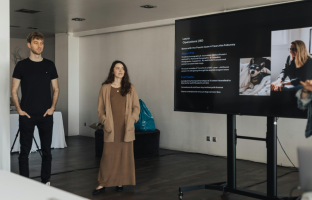Candidates consider many factors when seeking new job opportunities – location, role, benefits, and compensation to name just a few. Yet there is another element that may be more difficult to explain on paper but is just as critical: organizational culture.
There are many different ways organizational culture can be established and communicated. An organization may have an environment that encourages casual dress to promote individuality and comfort, it could fund advanced education and training, or it could establish a mentorship program to encourage professional growth. Another element of culture that impacts employee experience at an even deeper level, and can have a significant impact on the company’s bottom line, is psychological safety.
WHAT IS PSYCHOLOGICAL SAFETY?
In her book The Fearless Organization, Harvard Business School Professor Amy Edmondson describes psychological safety as “a climate in which people are comfortable expressing and being themselves.” In practice, this looks like creating a work environment in which employees feel secure in speaking their minds without fear of retribution or embarrassment.
There are obvious reasons psychological safety is good for business: incorporating new perspectives encourages innovation and can also increase productivity and safety. In a psychologically safe workplace, when mistakes are made and learned from, the company can move forward instead of repeating them in the future.
Psychological safety is also closely aligned with a company’s commitment to building a diverse and welcoming organization. It is widely recognized that diversity in teams has a positive impact on an organization’s output. Therefore, attracting and hiring employees from different backgrounds (including, but not limited to, race, gender, and ability) should be a priority. Diversity cannot stop at hiring, however; effective collaboration, along with employee retention and growth, are the true goals. To achieve these ends, leaders must create work environments where employees truly feel comfortable being themselves, and know that they can and should call out issues related to diversity and inclusion so that they can be addressed.
HOW TO CREATE A PSYCHOLOGICALLY SAFE ORGANIZATION
Professor Edmondson’s research led her to develop a Leadership Toolkit to help organizations achieve psychological safety. The three critical elements of that toolkit are setting the stage, inviting engagement, and responding proactively.
Setting the Stage
Before encouraging employees to be candid with one another when sharing feedback and ideas, leaders need to make a logical case for speaking up.
Edmondson uses the example of employees at a hospital. Speaking up in situations where there are safety concerns can save lives, which directly aligns with healthcare professionals’ collective goals and individual purposes. Appealing to employees’ motivations enables leaders to help team members unite under a common goal. By extension, setting the stage for employees to openly discuss issues around diversity and inclusion can connect back to goals of effective collaboration that produce exceptional products and services.
Furthermore, setting the stage is also about reframing failure. When leaders reframe failure as an opportunity for growth, acknowledging failure in an effort to solve problems becomes engrained in the culture, and employees become more resilient. Organizations that are unafraid to admit failure can learn from mistakes and move toward a more productive, safe, and innovative future.
Inviting Participation
After setting the stage by framing the reasons why candor is important, leaders need to encourage employees to engage in open conversation and feedback. Edmondson finds that organizations will often set the bar for participation too high, meaning that employees do not feel comfortable contributing to a conversation if their idea isn’t fully formed, is way outside the box, or contradicts someone else’s point of view.
As Edmondson notes that inviting participation needs to happen in a way that “people find compelling and genuine.” She recommends two key ways to achieve this; by adopting a mindset of situational humility and by engaging in proactive inquiry. Situational humility is a learning mindset that, when put into practice, can communicate to employees that bosses know they don’t have all the answers and that other voices are needed to achieve organizational goals.
Proactive inquiry means being curious and actively asking employees what your organization could be doing better. Leaders should ask specific questions that invite employees to evaluate their own performance, as well as processes, policies, and practices, with the understanding that the goal of evaluation is to increase effectiveness, not to place blame.
Ways to invite participation and knowledge sharing include focus groups, cross-functional teams charged with solving problems, peer-to-peer learning, digital suggestion boxes, and organizing staff meetings to leave time for everyone’s input.
Responding Proactively
A proactive response to feedback and input must be appreciative and respectful, and it must offer a path forward. While not all new ideas will be implemented, the goal of creating a psychologically safe environment is to ensure that employees know their voices are important.
Leaders who thank employees for speaking up and show them respect instead of vilifying or ignoring them encourage future participation. This seemingly simple practice goes a long way in creating an organizational culture that achieves excellence not by fearing failure, but by identifying problem areas and coming up with innovative solutions.
HOW TO INCORPORATE PSYCHOLOGICAL SAFETY INTO RECRUITING
Once psychological safety is engrained in your organization, communicating the impact of this culture to potential new hires is very impactful. Case studies about how your organization has developed more inclusive practices or created new products based on employee feedback, candor, and open discussion can be especially effective.
In addition, psychological safety can be included as part of the hiring process itself. Set the stage by explaining to candidates that they are evaluating you as an organization as much as you are evaluating them. Hiring is a two-way street and, when candidates are reminded of this, you both can find the right fit, which is beneficial in the long term. Invite candidates to ask questions. Explain to prospective hires that questions about culture, diversity, and opportunities for advancement are encouraged. Lastly, respond productively in recruiting by keeping lines of communication open. Transparency and a clear indication of next steps help to reduce anxiety.
For more on creating a psychologically safe workplace, see Professor Edmondson’s book The Fearless Organization: Creating Psychological Safety in the Workplace for Learning, Innovation, and Growth.







